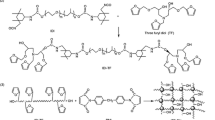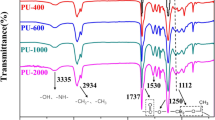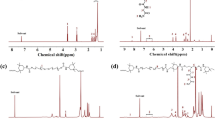Abstract
In this paper, a self-repairing polyurethane without external stimulation was synthesized. First, a reversible acyl hydrazone bond was introduced into the polyurethane molecular chain. The bond could be dynamically reversible under acidic stimulation to repair the material damage. After that, different contents of bis(2-ethylhexyl) phosphate components were added to modify the material in the synthesis, and its performance was compared to pure polyurethane (PU-0). The polymer was tested using digital viscometer, differential scanning calorimeter (DSC), thermogravimetric analysis (TG), tensile test, etc. The results showed that the addition of bis(2-ethylhexyl) phosphate can promote the healing of the material, so that the synthetic polyurethane material can be repaired to a certain extent without external stimulation.













Similar content being viewed by others
References
Lin CH, Sheng DK, Liu XD et al (2018) NIR induced self-healing electrical conductivity polyurethane/graphene nanocomposites based on Diels-Alder reaction. Polymer 140:150–157
Yoshie N, Watanabe M, Araki H et al (2010) Thermo-responsive mending of polymers crosslinked by thermally reversible covalent bond: Polymers from bisfuranic terminated poly(ethylene adipate)and tris-maleimide. Polym Degrad Stab 95:826–829
Turkenburg DH, Bracht HV, Funke B, Schmider M, Janke D, Fischer HR (2017) Polyurethane adhesives containing Diels-Alder based thermo-reversible bonds. Appl Polym Sci 134:44972
Galhenage TP, Hoffman D, Silbert SD et al (2016) Fouling-release performance of silicone oil-modified siloxane-polyurethane coatings. ACS Appl Mater Interfaces 8:29025–29036
Cornille A, Guillet C, Benyahya S et al (2016) Room temperature flexible isocyanate-free polyurethane foams. Eur Polym J 84:873–888
Burattini S, Greenland BW, Chappell D et al (2010) Healable polymeric materials: a tutorial review. Chem Soc Rev 39:1973–1985
Garrido MA, Gerecke AC, Heeb N et al (2017) Isocyanate emissions from pyrolysis of mattresses containing polyurethane foam. Chemosphere 168:667–675
Martin P (1997) Wound healing-aiming for perfect skin regeneration. Science 276:75–81
Wilson GO, Moore JS, White SR, Andersson HM et al (2008) Autonomic healing of epoxy vinyl esters via ring opening metathesis polymerization. Adv Funct Mater 18:44–52
Bleay SM, Loader CB, Hawyes VJ et al (2001) A smart repair system for polymer matrix composites. Compos PartA-Appl S 32:1767–1776
Toohey KS, Sottos NR, Lewis JA et al (2007) Self-healing materials with microvascular networks. Nat Mater 6:581–585
Williams HR, Trask RS, Bond IP (2008) Self-healing sandwich panels: Restoration of compressive strength after impact. Compos Sci Technol 68:3171–3177
Watanabe M, Yoshie N (2006) Synthesis and properties of readily recyclable polymers from bisfuranic terminated poly(ethylene adipate) and multi-maleimide linkers. Polymer 47:4946–4952
Deng G, Tang C, Li F et al (2010) Covalent cross-linked polymer gels with reversible sol-gel transition and self-healing properties. Macromolecules 43:1191–1194
Yuan C, Rong MZ, Zhang MQ (2014) Self-healing polyurethane elastomer with thermally reversible alkoxyamines ascrosslinkages. Polymer 55(7):1782–1791
Li JH, Zhang GP, Sun R et al (2018) Self-healing and shape memory linear polyurethane based on disulfide linkages with excellent mechanical property. Macromol Res 26:365–373
Marschner DE, Frisch H, Offenloch JT et al (2018) Visible light [2 + 2] cycloadditions for reversible polymer ligation. Macromolecules 51:3802–3807
Xiang Z, Zhang L, Yuan T et al (2018) Healability demonstrates enhanced shape-recovery of graphene-oxide-reinforced shape-memory polymeric films. ACS Appl Mater Interfaces 10:2897–2906
Yang L, Lu XL, Wang ZH et al (2018) Diels-Alder dynamic crosslinked polyurethane/ polydopamine composites with NIR triggeredself-healing function. Polym Chem 9:2166–2172
Duarah R, Karak N (2018) High performing smart hyperbranched polyurethane nanocomposites with efficient self-healing, self-cleaning and photocatalytic attributes. New J Chem 42:2167–2179
Li JH, Liu Q, Ho D et al (2018) Three-dimensional graphene structure for healable flexible electronics based on Diels−Alder chemistry. ACS Appl Mater Interfaces 10:9727–9735
Yang YL, Lu X, Wang WW (2017) A tough polyurethane elastomer with self-healing ability. Mater Des 127:30–36
Feng LB, Yu ZY, Bian YH et al (2017) Self-healing behavior of polyurethanes based on dual actions of thermo-reversible Diels-Alder reaction and thermal movement of molecular chains. Polymer 124:48–59
Jian XX, Hu YW, Zhou WL et al (2018) Self-healing polyurethane based on disulfide bond and hydrogen bond. Polym Adv Technol 29:463–469
Cheng CJ, Li J, Yang FH, Wang JL et al (2018) Renewable eugenol-based functional polymers with self-healing and high temperature resistance properties. J Polym Res 25:57
Wu XX, Li JH, Li G et al (2018) Heat-triggered poly(siloxane-urethane)s based on disulfide bonds for self-healing application. J Appl Polym Sci 135:46532
Ma XY, Shi CY, Huang XW et al (2019) Effect of natural melanin nanoparticles on a self-healing cross-linked polyurethane. Polym J 51:547–558
Chang R, Wang X, Li X et al (2016) Self-activated healable hydrogels with reversible temperature responsiveness. ACS Appl Mater Interfaces 8:25544–25551
Wang L, Deng F, Wang W et al (2018) Construction of injectable self-healing Macroporous hydrogels via a template-free method for tissue engineering and drug delivery. ACS Appl Mater Interfaces 10:36721–36732
Ruff Y, Lehn JM (2008) Glycodynamers: fluorescent dynamic analogues of polysaccharides. Angew Chem Int Ed 47(19):3556–3559
He L, Jiang Y, Tu C et al (2010) Self-assembled encapsulation systems with pH tunable release property based on reversible covalent bond. Chem Commun 46(40):7569–7571
Deng G, Li F, Yu H et al (2012) Dynamic hydrogels with an environmental adaptive self-healing ability and dual responsive sol−gel transitions. ACS Macro Lett 1:275–279
Zhang P, Deng F, Peng Y et al (2014) Redox- and pH-responsive polymer gels with reversible sol–gel transitions and self-healing properties. RSC Adv 4:47361–47367
Lu S, Bai X, Liu H et al (2017) An injectable and self-healing hydrogel with covalent cross-linking in vivo for cranial bone repair. J Mater Chem B 5:3739–3748
Wang Y, Yu H, Yang H et al (2017) an injectable interpenetrating polymer network hydrogel with tunable mechanical properties and self-healing abilities. Macromol Chem Phys 218:1700348
Huang X, Wang X, Shi C, Liu Y, Wei Y (2021) Research on synthesis and self-healing properties of interpenetrating network hydrogels based on reversible covalent and reversible non-covalent bonds. J Polym Res 28(1):1–13
Ma X, Shi C, Huang X, Liu Y, Wei Y (2019) Effect of natural melanin nanoparticles on a self-healing cross-linked polyurethane. Polym J 51(6):547–558
Acknowledgements
This work was supported by the National Natural Science Foundation of China (Grant No. 51103078).
Author information
Authors and Affiliations
Corresponding author
Additional information
Publisher's Note
Springer Nature remains neutral with regard to jurisdictional claims in published maps and institutional affiliations.
Rights and permissions
About this article
Cite this article
Chen, Y., Shi, C., Zhang, Z. et al. Preparation and properties of self-healing polyurethane without external stimulation. Polym. Bull. 79, 10723–10739 (2022). https://doi.org/10.1007/s00289-022-04075-8
Received:
Revised:
Accepted:
Published:
Issue Date:
DOI: https://doi.org/10.1007/s00289-022-04075-8




